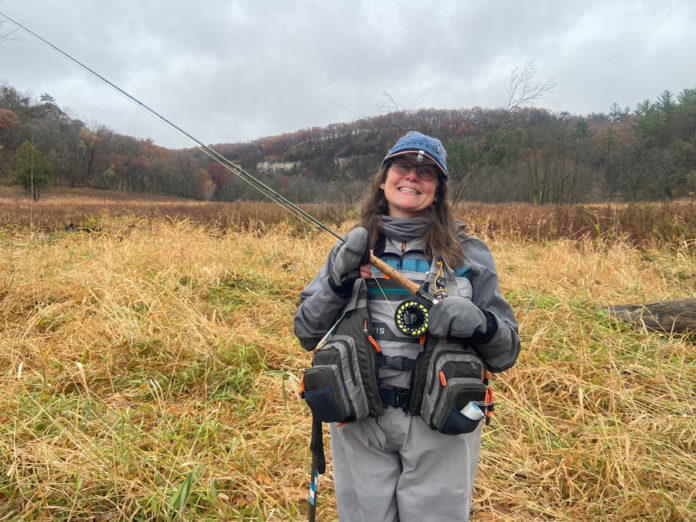Written by: Evan Jones
The Driftless Region covers 24,000 square miles of hills and valleys, sprawling mostly across the southern reaches of Minnesota and Wisconsin. Famous for an abundance of spring-fed trout streams, many of which are open to fishing year-round, it has been a popular destination for fly anglers ever since fly angling became popular. The Driftless Fly Fishing Company in Preston, Minnesota, has been plying these waters for more than two decades, and the same can be said for Monta Hayner, one of their more experienced guides. She was kind enough to take time to answer 5 Questions for us, describing her career growth from newbie all the way up to leadership roles in multiple fly-fishing organizations, and talking about some of the memorable milestones along the way.
1. How did you get started fly-fishing?
I grew up trout fishing with my family in Michigan and Oregon. When I moved to Minnesota with my husband, I had no idea there were trout steams here. Everyone I knew went up north to fish the lakes. When my brother Melvin moved to Minnesota about 10 years later, he introduced me to the Driftless Region. That was a little over 20 years ago. I then took a weekend fly-fishing class at an Environmental Learning Center, andI’ve been fly-fishing with my brother ever since.
2. What’s your favorite species to fish for and why?
My favorite species to fish for are native trout. When I travel, I try for the native trout in that location. It was cutthroats in Oregon, brown trout in Scotland, and I recently tried unsuccessfully for a Rio Grande cutthroat in Colorado. In the Driftless, brook trout are the natives. Brook trout require the coolest, cleanest water, so they are usually found in very clear water and require a very stealthy approach. When I land one, I’ve met the challenge.
3. Describe some of the ways you’ve found to give back to the fly-fishing community over the course of your career
I am a past President of Fly Fishing Women of Minnesota, and I continue to volunteer with this club as a mentor and teacher. I am currently the Women Connect Liaison for Fly Fishers International Upper Midwest Council, as well as a board member of the Upper Midwest Council and the Lew Jewett Fly Fishing Club. I believe it is important to give back by mentoring, teaching, and leading. It’s not a big commitment to help with your local club, usually a monthly meeting and volunteering at a few events. It means so much to people who are just getting started in this sport. I also feel that every person I help to enjoy fly-fishing is another person who will care about our cold water streams and the environment.

4. You’re probably no stranger to “mansplaining” when it comes to fishing; tell us about a time you got the best of a know-it-all.
The thing I get a kick out of is going into a fly shop with my husband. They immediately start talking to him. He listens, then says something to the effect of, “Um, I’m not really the fly fisher; my wife is a fly-fishing guide.” By then I’ve already checked to see if they carry anything in women’s sizes. I’m starting to see this change as more women get into fly fishing; the store clerks are indeed taking notice and changing their behavior.
By and large, the men I have met who fly fish in the upper Midwest have been very supportive. I think this is mostly a reflection on fly fishing and those who take it up. What I don’t care for are the films that depict fly fishing as a “hunting” sport. It is so much more than how many or how large a fish you catch. It is about learning subtleties, being one with your environment and how everything is connected.

5. What makes the Driftless Area a great place to fish?
The Driftless is an area comprising Minnesota, Wisconsin, Iowa and Illinois that was never covered by glaciers during the last ice age. The area was once a great ocean, so the rock formations are limestone that has been carved by the melting ice, creating valleys with beautiful cliffs, caves, and most importantly, cold-water springs that feed the streams. The water stays cool all year long, as it comes out of the ground. The best streams continue to be fed by springs along the way as they move toward the Mississippi River. It is a great habitat for freshwater insects and the fish they feed. Minnesota has more than 700 miles of designated trout stream with more than 200 miles of angler easements. I was out fishing on a really crowded Saturday this spring and was able to find public access that had no anglers.
To learn more about Monta or the Driftless Area, check out The Driftless Fly-Fishing Company.
Credit: Source link






























